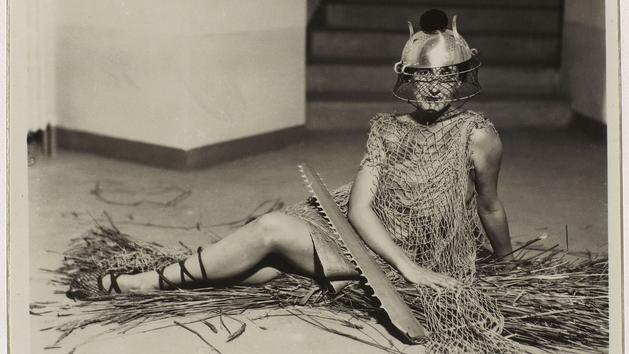Is there a little-known facet of the undisputed master of modern photography, Emmanuel Radnitsky, aka Man Ray (1890-1976)?
This is the bet of the “Man Ray and fashion” exhibition, which reopens the Luxembourg Museum to the public.
To the general public?
Fashion is fashionable.
Photography and fashion now go hand in hand.
As evidenced by last year, the success of “Dora Maar” at the Tate Modern, in London, after that of the Center Pompidou.
As evidenced by the offensives of the genre at the Rencontres d'Arles and the programming of Simon Baker at the MEP (European House of Photography) in Paris.
Lee Miller, Face Painted, circa 1930, Man Ray.
private collection, courtesy Fondazione Marconi / Man Ray 2015 Trust / Adagp, Paris 2020
Here is the friend of Jean Arp, Max Ernst, André Masson, Joan Miro and Picasso far from the avant-garde.
The American who arrived in Paris in 1921, who pushed the photogram technique to perfection and invented, with Lee Miller, the solarization process, is here propelled into the world of cosmetic advertising and magazine orders.
A desecrated statue or another look at an alliance that tells the story of society, from morning to night?
"He erases the mercenary origin of his commissioned works"
The visit begins with his first encounter in 1922 with sewing through the figure of Paul Poiret, whose portrait he is to draw.
The esthete sends the inventor of rayograms for a walk in his salons.
Man Ray “shoots” the models and returns with his prints in the hope of selling them to the designer… who, absolutely not interested, advises him to submit them to a fashion magazine.
The artist begins his first collaborations, publishes portraits in
Vanity Fair.
Then
Vogue
.
It will be the legendary
Noire et Blanche
(1926), in which he poses Kiki de Montparnasse with a Baoulé mask.
Evening dress in black crepe printed by Elsa Schiaparelli, Man Ray,
Harper's Bazaar
March 1936 © Galliera / Parisienne de Photographie © Man Ray 2015 Trust / Adagp, Paris 2020
In 1933, he was hired by the legendary
Harper's Bazaar
of Carmel Snow and Alexey Brodovitch.
The same year, he staged
Les Larmes
, de cristal, under the eyes of a cabaret dancer whose gaze he reframed into a modern statue.
It is in fact an advertisement for the waterproof mascara Cosmécil, whose slogan is
"Cry at the cinema, cry at the theater, laugh until tears, without fear for your beautiful eyes ..."
This mythical photograph, present in the collection of Elton John , is published the following year, cropped, in the
Cahiers d'art
, a review founded in 1926 by Christian Zervos.
"Man Ray is already erasing the mercenary origin of his commissioned works",
explains Alain Sayag, scientific curator of the exhibition.
"However, while the time saw the rise of advertising and fashion as part of modernity, Man Ray was very successful in this environment
," continues Catherine Örmen, fashion historian.
He plays on his surrealist artist side, his reputation as a provocateur and his aesthetic which derealizes objects. "
"Tell the story of the company"
Nancy Cunard and her bracelets, Lee Miller and her solarized blonde, Peggy Guggenheim and her heiress evening dresses, Marie-Laure de Noailles and her insane ball costumes… So many portraits, presented here, which have influenced fashion.
Like Martin Margiela, reference designer at the end of the 20th century:
“I did not realize how much Man Ray had counted in the formation of my taste… It was through the reactions of others that I understood how much his surrealism was in me and continues to be. "
The Hair, 1929, Man Ray.
© private collection, courtesy Fondazione Marconi © Man Ray 2015 Trust / Adagp, Paris 2020
The vintage of this pump placed on a miniature stepladder refers to the erudite humor of Guy Bourdin in his advertisements for Charles Jourdan of the 1970s. The hat model published in
Harper's Bazaar
under the title
La Mode au Congo
(avant-garde fusion of modern art and primitive arts) will reappear almost identically in
The Face
: the very first portrait of Kate Moss by Corinne Day in 1990.
A legacy that Man Ray would have denied, according to Alain Sayag.
So why choose this angle?
“It's not an instrumentalisation of fashion
,” says Catherine Örmen.
Fashion is a social phenomenon that must be treated as such; institutions have fallen behind in relation to this discipline.
It is legitimate for her to come straight into the museum, all the more so as she can give them a boost. "
“You know, photography is a mediocre and illegitimate art just like fashion
, dares to say Alain Sayag, this great name in photography.
For us it is simply a way of telling the story of the company.
People need to be told their story and that's what we try to do more or less skillfully.
This is the first time that the word mode has been used in the title of an exhibition at the museum.
It is also the desire of the RMN to attract a younger audience to this place of painting. ”
“Man Ray and fashion” exhibition, until January 17, 2021, at the Luxembourg Museum, 19, rue de Vaugirard (Paris 6th).
museeduluxembourg.fr

